The Alphacool Eisbaer 240 CPU AIO Liquid Cooler Review
by E. Fylladitakis on August 1, 2016 9:00 AM EST- Posted in
- Cases/Cooling/PSUs
- AIO
- Water Cooling
- Cooler
- Alphacool
The Alphacool Eisbaer 240 CPU Liquid Cooler
Even though the radiator of the Eisbaer strongly resembles the radiators of many other AIO liquid coolers, the rest of the assembly is unique compared to any other that we have seen up to this date. To begin with, while the Eisbaer is upplied assembled and prefilled but it actually is a standard liquid cooling kit, as the tubing is not permanently attached on either the radiator or the block/pump assembly. Typical tubing compression fittings are used on both parts that can be undone at any time by the user.
The glossy black tubing of Eisbaer appears to be made out of PVC and has an internal diameter of 11 mm, which is much more than sufficient for a simple system with just one block. A black spring surrounds the glossy black tubing, preventing it from kinking when taking sharp turns. Alphacool also included a plastic connector on one of the tubes, offering the option of relatively quick future upgrades.
The radiator of the Eisbaer may be visually almost identical with the radiators used by many other products. A closer inspection however reveals a major difference: both the channels and the fins of this radiator are made out of copper. This makes the radiator a little heavier and considerably more expensive to manufacture, but it should also offer a noteworthy performance boost. The company logo can be seen printed on the sides of the steel frame.
Eisbaer’s block/pump assembly is quite tall but not very wide, with a plastic body and a copper base. There is a fill tap on the top of the assembly, allowing the user to refill and maintain the system. The company’s logo has LED lights installed and will illuminate blue once the pump is powered on. A little window on the side reveals the pump and fluid to the user. As this would not be visible from the side panel of the case, Alphacool did not install LEDs inside the block.
Inside the assembly we can see one of Alphacool’s pump designs based on the DC-LT Ceramic 12V pumps. The maximum flow is 70 L/h and it has a head of 0.85 m, figures that may not be great compared to those of large external pumps, yet are impressive for such a small device.
The copper base of the cooler is very smooth and appears to have been machined down to a perfect mirror finish. Unfortunately, copper is very easily oxidized and we received one of the pre-production samples that only had a temporary protective sticker attached. It was not attached well and the trapped air oxidized the base of our sample, creating an abstract canvas. This cannot and will not affect the performance of the cooler in any way, it is a mere aesthetic mishap that degrades the appearance of the product.


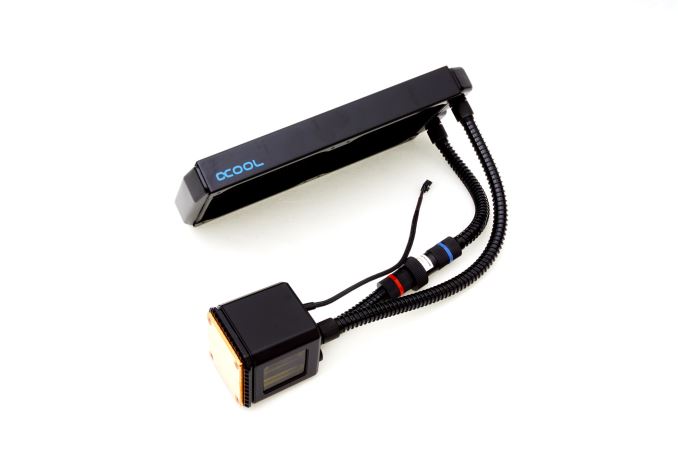
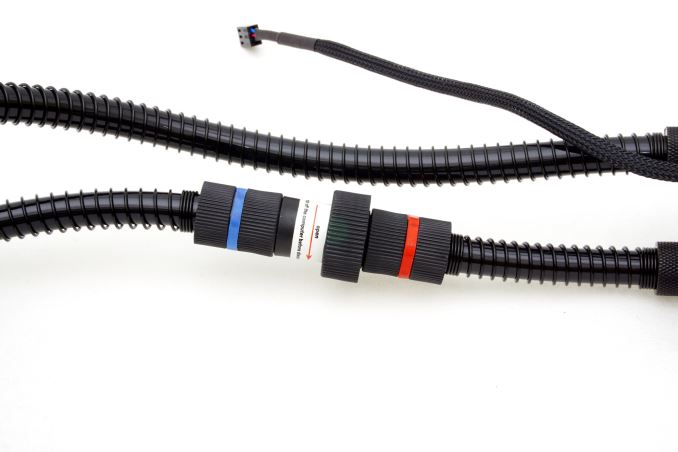
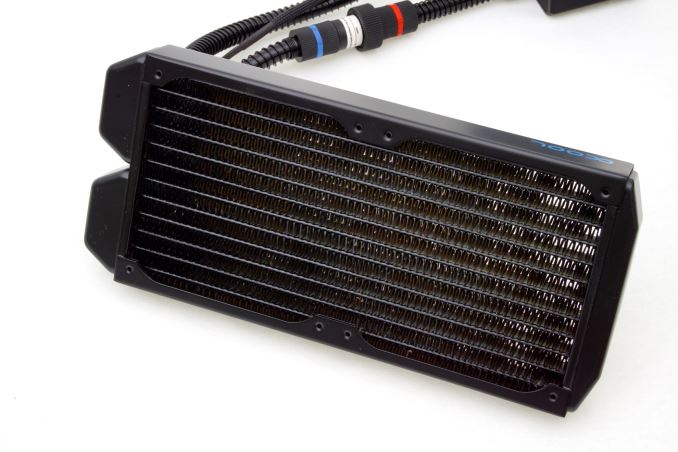
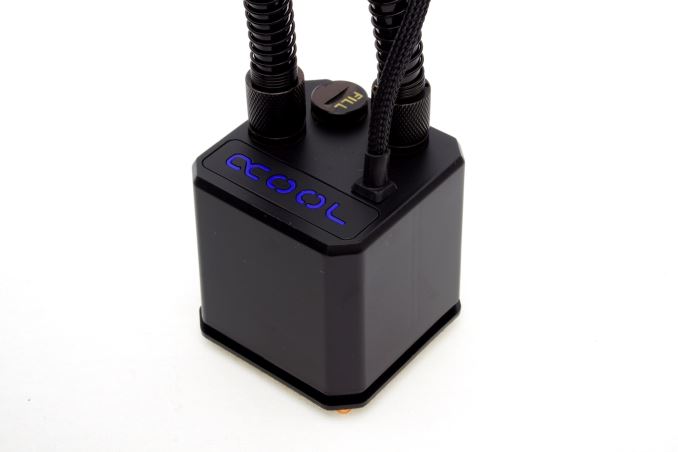
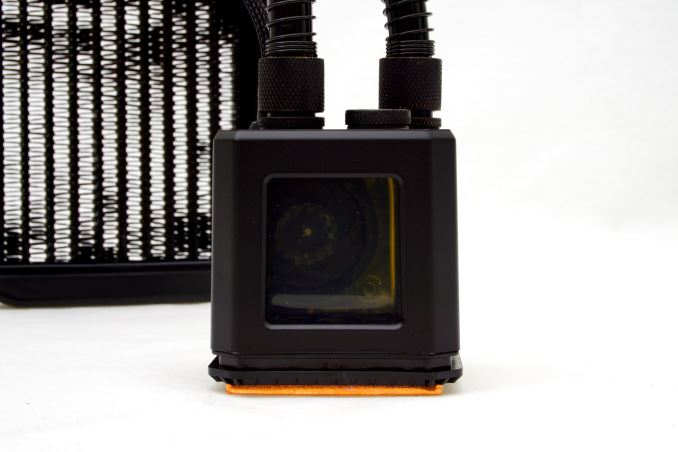









69 Comments
View All Comments
HomeworldFound - Tuesday, August 2, 2016 - link
I've used quite a lot of watercooling gear and actually own quite a few Alphacool products. 6 radiators from 360mm to 480mm at the least. I think the company is overlooked a lot but the products they offer are sound. I'm not sure about their All-In-One coolers but as a long term watercoooling part provider I would trust them more than brands with no experience.HomeworldFound - Tuesday, August 2, 2016 - link
P.S I trust Alphacool far more than say.. EKWB.. that company has had so many scandals that it tried to brush under the rug and even blamed its customers for its manufacturing failures.ikjadoon - Tuesday, August 2, 2016 - link
Ouch. How did EKWB, a huge brand in terms of custom water-cooling, release a product that leaks more often than a Corsair kit, which came from Asetek anyways?http://www.guru3d.com/news-story/ekwb-issues-recal...
Do you have any info on blaming consumers? I can't seem to find that online.
Frangelina - Tuesday, August 2, 2016 - link
Exciting to see Alpha keep going. Alpha was the Beatles of cooling in the 90's. I am sure Anand remember. Alpha said "adios" to the "default" cooling from Intel or Amd. I bet it is an excellent product. My brain does not have as much time for the games anymore, but I felt I had to write something positive coming from my memories. They inspired Thermalright!know of fence - Thursday, August 4, 2016 - link
It's nice that AT now uses a heating plate setup to test coolers. I'd like to see some line graphs next, even if it doesn't include direct comparisons to other coolers, it still shows how performance increases with ramping RPMs.Also some on the BOX information, like the wattage of Pump and Fans would be nice, after all these AIO plumbing solutions consume more electricity in idle than a CPU at this point!
Is there any info on the MTTF.
Do they throttle down when my CPU runs 0.8 GHz and 0.8 V or they still continue to tirelessly push liquid in a circle? How do you set up a FAN profile considering the delay, that is inherent to any water based system.
Will we ever get apples to apples comparisons, is it possible to fix other meaningful variables than Wattage (and even less meaningful like FAN Voltage), for instance compare different noise at the same thermal resistance or compare thermal resistance at a constant dBA level?
wylie102 - Monday, August 29, 2016 - link
Okay so if we assume modern CPUs don't require as much cooling and air coolers can be roughly as effective as liquid AIO options. Also GPUs should potentially be the focus of our cooling setup.Given this is there any benefit to the fact that you can arrange the AIO cooler to vent the warm air directly or of the case therefore reducing the ambient temp in the case and enabling the rest of the case ventilation to better cool the graphics card(s)?
Wouldn't this be a more cost effective option than buying water cooled GPUs given that AIO options are widely available and aren't too much of a cost increase?
For example I read a bit around running graphics cards in SLI and there are documented performance improvements when 1. The cards are spaced more widely and 2. One is a blower and one open air (as long as they are arranged correctly).
This suggests that ambient case temperature around the cards affects performance. Surely since an AIO cooler vents heat out rather than in there could be some benefits to the GPU From water cooling the GPU for less money than upgrading to a water chilled GPU?
wylie102 - Monday, August 29, 2016 - link
Edit: I'm typing on a tablet and autocorrect screwed me.Last sentence should hypothesise there's a benefit to the GPU From water cooling the CPU and that this might be more cost effective than water cooling the GPUs themselves.
Thoughts on this?
SeanJ76 - Tuesday, October 25, 2016 - link
Hyper Evo best $25 coolerElcs - Saturday, November 26, 2016 - link
No 120mm and 360mm review?